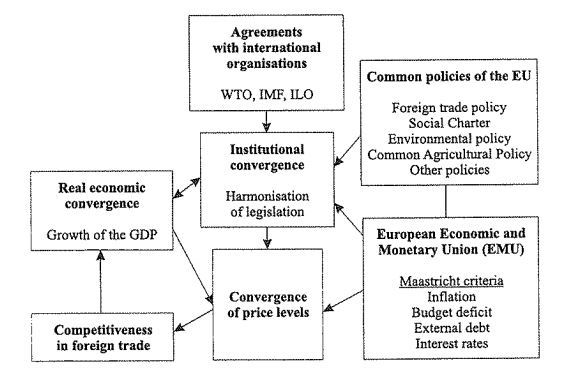European Union Accession through Integration and Convergence
Estonia’s integration into the EU has three levels of convergence: nominal, real and institutional convergence.
The first of these concerns is the harmonisation of prices between Estonia and the European Union, while the second focuses on increasing domestic income levels to that of the EU. Under institutional convergence, we mainly understand the transposition of acquis communautaire.1 A key aspect of negotiations with the EU is that Estonia should avoid transposing provisions that would lead to a rapid increase in prices and erode the country’s competitive ability. If the harmonisation of Estonian legislation with EU provisions is pushed forward very rapidly, it will place an additional and substantial burden on domestic business, and thus reduce their ability to compete on an international level. So far, institutional convergence has pushed up the convergence of prices, while the convergence in income has been less visible.
Fig. 1. Institutional, price and income convergence in the process of accession to the European Union

EU integration is likely to focus more than anything on three sectors – environmental protection, social affairs and agriculture. In all of these sectors, the harmonisation of Estonian legislation with EU requirements places a heavy burden on Estonia. Investments are required not only from authorities, but also from individual companies, which wish to compete with other EU undertakings. In this aspect, agriculture seems to be the greatest concern for the public. The Estonian government has declared that Estonia’s agricultural policy will be harmonised with the Common Agricultural Policy, and with CAP-related policies. It is a decision that is likely to bring about a significant increase in domestic prices.
There are two risks involved with institutional convergence. First, it has progressed so rapidly that it could become an obstacle for real convergence if a large section of the population one day finds that they are unable to pay for food. In addition, stricter requirements on production hygiene and other aspects could bankrupt domestic businesses. If the Estonian government wishes to avoid shocking its people and economy, the best way would be to start wringing out concessions from the EU in the form of transition periods.2
1Artis M. J., Lee N. (1994) The Economics of the European Union. Policy and Analysis. Oxford Uni. Press, 432 p.; + see http://europa.eu.int/comm/enlargement/agenda2000/strong/33an.htm 15/01/2001. Hunya, G. FDI penetration and performance in CEECs 1994-1998. Vienna, WIIW, 2000. Impact Study. Agenda 2000. 15/07/1997. http://europe.eu.int/comm/enlargement/impact24.htm
2See Randveer, M. (2000) Convergence of Income Levels between the European Union and the States Preparing for the Accession – http://www.ee/epbe/papers/6_2000/index.pdf.et – 01.02.01; Regular Report from the Commission on Estonia’s Progress towards Accession ’99. http://europa.eu.int/comm/enlargement/dwn/report_10_99/en/word/estonia.doc – 15.01.01.
